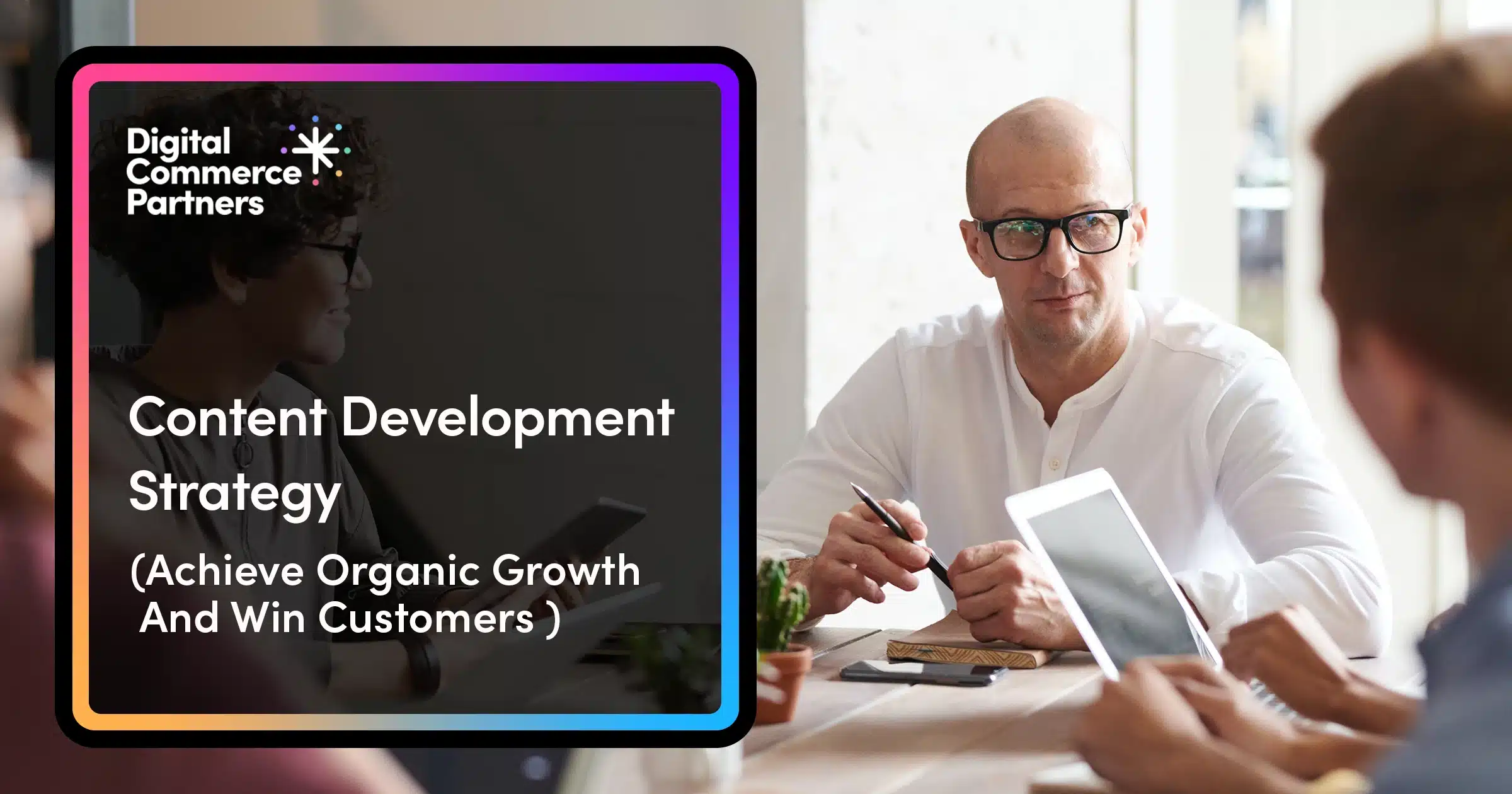A quality content development strategy is crucial if you want to optimize organic growth and drive traffic to your website. For this reason, it’s one of the key services that we offer.
It’s the difference between publishing content that floats into the void and content that drives real business results. When done right, it builds authority, earns trust, and turns traffic into revenue.
Just look at our own numbers. The first graph shows this website before January 2024:
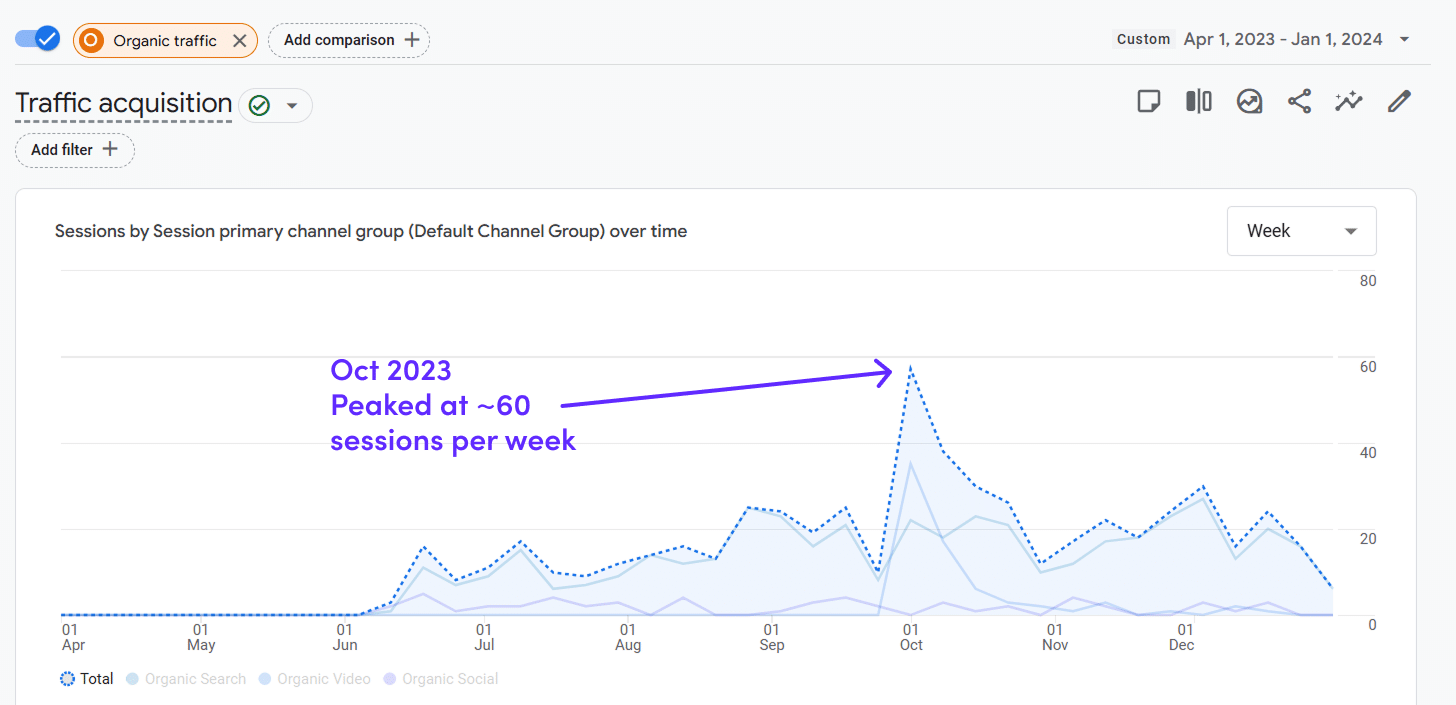
And here’s what happened after we implemented the very strategy we’re about to share with you:
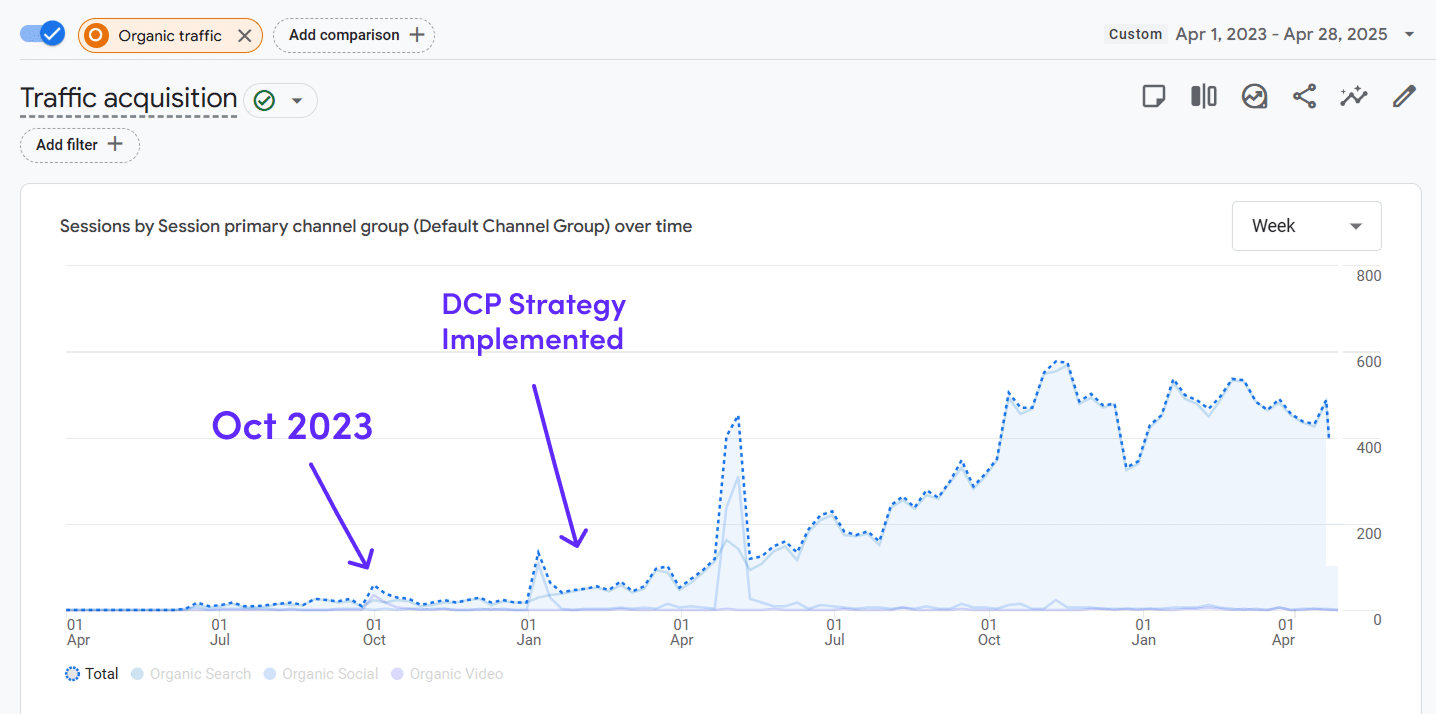
In this article, I’ll walk you through the 12 steps we take to build a content strategy that converts, whether it’s for our own site or a client.
Originally published on March 7th, 2022, this article was updated and republished on May 27th, 2025.
Get more leads with less effort.
If you want a steady flow of targeted leads, we’ve got a proven process for driving organic traffic and converting it into qualified leads.
What Is Content Development (and Why Does it Matter?)
Content development is about creating content with a clear business purpose. That means planning, writing, optimizing, and distributing content that meets real customer needs and actually drives results.
Start with the end goal in mind: revenue. Instead of chasing traffic for traffic’s sake, focus on the paths that lead to sales: building content around the questions, problems, and decisions that matter most to your ideal customers.
Of course, even the best content won’t work if it’s buried or disconnected. That’s why it’s important to tie everything together with a strong site structure. Strategic use of navigation menus, content hubs, and internal linking helps search engines understand your content, which helps you rank. It’s also how visitors will find what they need and take action.
Done right, content becomes more than a traffic driver. It becomes a scalable system for attracting the right audience, building trust, and converting that attention into long-term growth.
Whether you’re developing a content strategy from scratch or refining your current one, the goal is simple:
To resonate with your ideal clients at scale and do it consistently enough to drive measurable results for your bottom line.
Our Proven Content Creation Strategy (and How to Implement It into Your Business)
A successful content creation strategy starts by developing a deep understanding of your customers and the competitive environment in which you operate.
This includes analyzing how your audience thinks, what influences their decisions, and what makes your product or service stand out in the market.
This early research clarifies how to build a strategy tailored specifically to your business, one that’s grounded in real buyer behavior and market dynamics.
With that foundation in place, every piece of content can be designed to attract the right people, keep them engaged, and move them closer to taking action.
So if you’re wondering how to create a content strategy, let’s look at the steps in our process below.
1. Define Revenue-Driven Goals
Before producing a single piece of content, begin with the outcome we’re trying to achieve and build the strategy backward from there.
For ecommerce, that often means optimizing product and category pages, where revenue impact can be directly measured.
In these cases, content is designed to drive specific outcomes, such as increasing traffic to high-margin categories, boosting conversions for top-selling items, or ranking for purchase-ready queries.
For non-ecommerce businesses—like those offering memberships, courses, or services—the target might be a landing page, lead magnet, or demo request form.

Regardless of the model, we define success in clear, measurable terms: form submissions, qualified leads, webinar signups, or email conversions.
This clarity sets everything in motion. We’re not just chasing keywords or publishing content for volume. Every asset we create is mapped to a business objective and structured to drive a meaningful next step. It doesn’t matter whether that’s a sale, a signup, or a deeper move through the funnel.
When content is tied directly to revenue outcomes, it shifts from a marketing expense to a performance engine, one that fuels scalable, measurable growth.
2. Perform a Tracking Audit
Defining goals is only one part of the equation. Equally critical is the ability to track whether content is actually driving those outcomes.
That’s why one of our first steps is always a tracking audit. You can check whether lead forms trigger goals, ensure ecommerce events are firing correctly, and verify that each page’s performance can be monitored at a granular level.
Too often, we begin work on a new project and find that tracking is either nonexistent or misconfigured. Clients may have published dozens (or hundreds) of blog posts and landing pages. Without proper tracking, it is impossible to know which pages attract the right traffic or which CTAs convert visitors into leads.
In ecommerce, the path is often more straightforward. However, you can still see issues: disconnects between Shopify and Google Analytics, inconsistent attribution, or missing event tags that obscure where sales are coming from.


For service-based businesses, it’s common to see a generic “thank you” page after form submissions, without event tracking or goal completions set up. This makes it difficult to tie conversions to specific traffic sources or content assets.
This foundation turns content from a cost center into a performance engine that drives scalable, measurable growth.
3. Analyze the Competitive Landscape
Once goals are in place, it’s time to focus on the competitive landscape. This helps you understand how your top competitors use content to capture demand and spot the strategic opportunities they’re missing.
Start by identifying who’s competing with you in search. That includes not just direct business competitors, but any site ranking for the keywords your ideal customers use.
From there, analyze the pages driving their traffic, the topics they prioritize, and how they structure their content to perform.
Don’t just copy what’s working. Go deeper:
- Is the traffic they’re getting actually aligned with buyer intent?
- Are they fixated on high-volume keywords that are hard to rank for, while missing lower-volume queries with high conversion potential?
- Is their content surface-level, outdated, or lacking the authority and clarity customers need to make a decision?
Take Seven Sons, for example. Competing in the crowded ethical meat space, they were up against big players targeting broad terms like “grass-fed beef” and “organic meat.”
But many of those competitors weren’t answering the nuanced, trust-building questions buyers were actually asking, like “What does pasture-raised really mean?” or “How is grass-fed different from organic?”
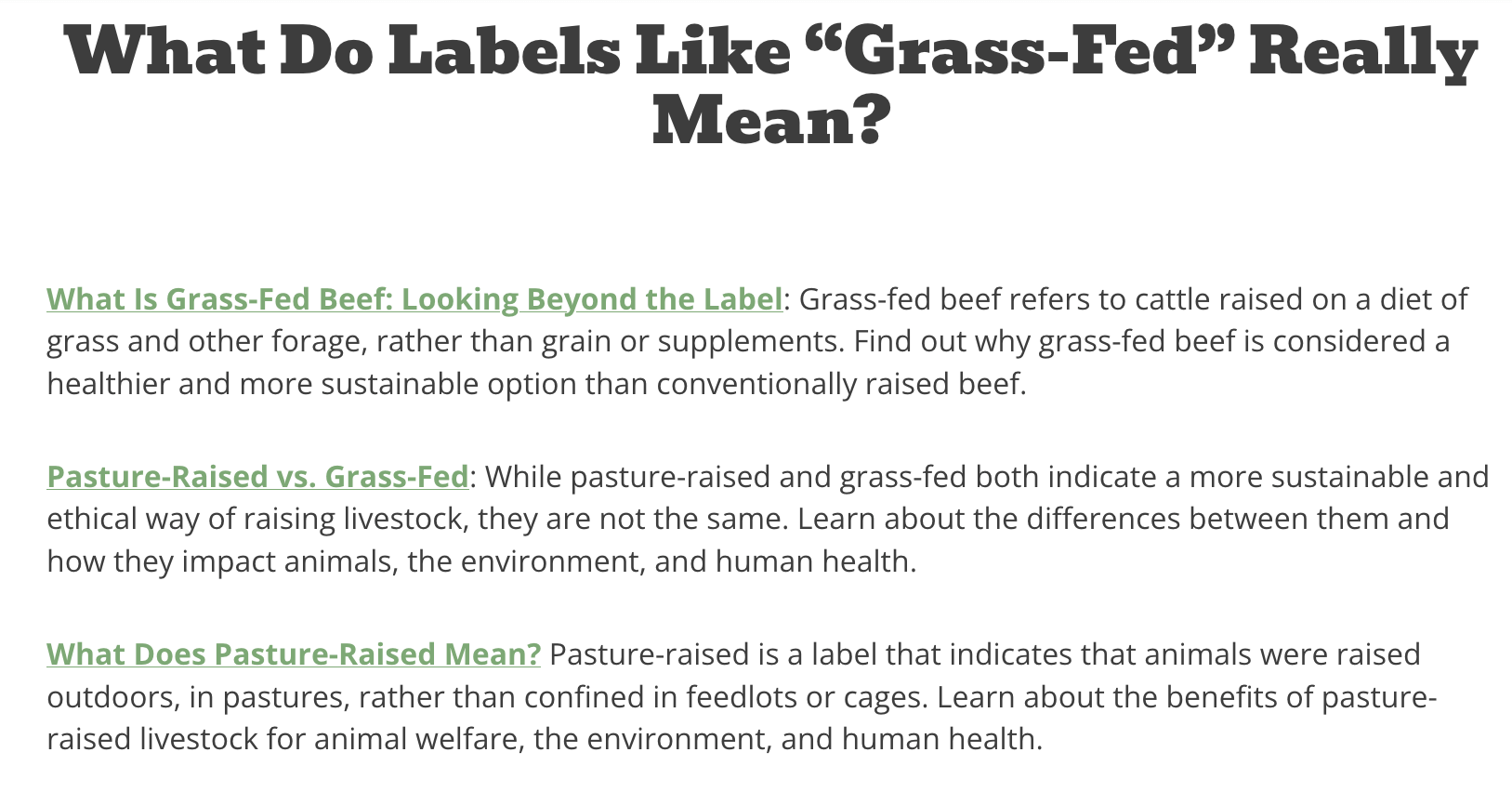
Seven Sons had already documented these questions through years of customer conversations. We turned that into a competitive advantage by creating content that answered these mid-funnel, high-intent queries with clarity and authority.
This kind of analysis helps us map the content you actually need to compete. Not just to outrank competitors, but to outmatch them by targeting opportunities they’re overlooking and aligning every piece of content with real buyer behavior.
This leads to the next step in the content development process:
4. Map the Customer Journey
A high-performing content strategy generates traffic, guides the right people through the buyer’s journey, and turns early interest into confident conversions.
That means each piece of content must be intentionally aligned with both search intent and stage of awareness, ensuring it clearly moves prospects toward your business goals.
Rather than starting with a list of keywords and sorting by search volume, ask, “Where is the buyer in their journey, and what do they need to know next to take action?”
This approach turns your website into a strategic conversion funnel. Whether someone is discovering a problem or comparing providers, there’s a path forward—and your content becomes the guide.

It’s helpful to think of the customer journey as being in stages of awareness. Eugene Schwartz outlined these stages in his brilliant book Breakthrough Advertising:
- Most Aware: Your prospect knows your product and only needs to know “how to buy.”
- Product-Aware: Your prospect knows what you sell, but isn’t sure it’s the right solution.
- Solution-Aware: Your prospect knows the desired result but isn’t sure your product provides it.
- Problem-Aware: Your prospect knows they have a problem, but doesn’t know there’s a solution.
- Completely Unaware: The prospect has no knowledge of anything except, perhaps, their own identity or opinion.
By aligning content with these stages, we can prioritize what to create based on what will actually move the needle. For example, problem-aware content might drive traffic, but product-aware or most-aware content deserves more focus if your biggest revenue gap is lower-funnel conversions.
This is exactly how we approach content strategy at DCP. You can’t rely on bottom-funnel content alone for highly competitive head terms like “ecommerce SEO.” So, we build layered strategies that address different needs at different stages.
For product-aware visitors, we create focused service pages that speak directly to intent (like our ecommerce SEO services). We also publish informational blog posts to support rankings and reach buyers earlier (like the one you’re reading now!). These posts answer common questions, compare options, and guide readers toward the right solution.
This full-funnel approach helps brands win in competitive spaces by combining search visibility and buyer readiness.
5. Keyword Strategy
Keyword strategy is where raw research becomes a real growth plan. To start, prioritize keywords based on their potential to attract, engage, and convert ideal customers. It’s one of the key benefits of ecommerce SEO—with the right keywords, the customers find you.

Focus on identifying the right opportunities—keywords that match user intent, align with your business goals, and are realistically winnable based on your current site authority.
Here’s how to build it:
- Buyer Intent Mapping: Categorize every keyword based on its place in the customer journey—awareness, evaluation, or decision. Content must meet users where they are, not where we hope they’ll be.
- Business Alignment: Prioritize keywords directly supporting clients’ products, services, or revenue goals. Traffic alone isn’t enough; it needs to be the right traffic.
- Content Gap Analysis: Look for terms competitors are overlooking or covering poorly. These gaps are often faster wins with less competition.
- Feasibility Scoring: Assess keyword difficulty against your current domain authority and focus on achievable targets. In the early stages, it’s wise to favor low-to-mid-competition keywords to deliver quicker traction.
- Quick Wins and Cornerstones: Identify existing pages that can be updated to climb quickly (“quick wins”) and map out larger strategic hubs (“cornerstones”) that can anchor future content clusters.
6. The 6-Week Editorial Calendar
Once you have a prioritized list of keywords aligned by intent, stage, and opportunity, develop a six-week editorial calendar that outlines exactly what to publish, when, and why.
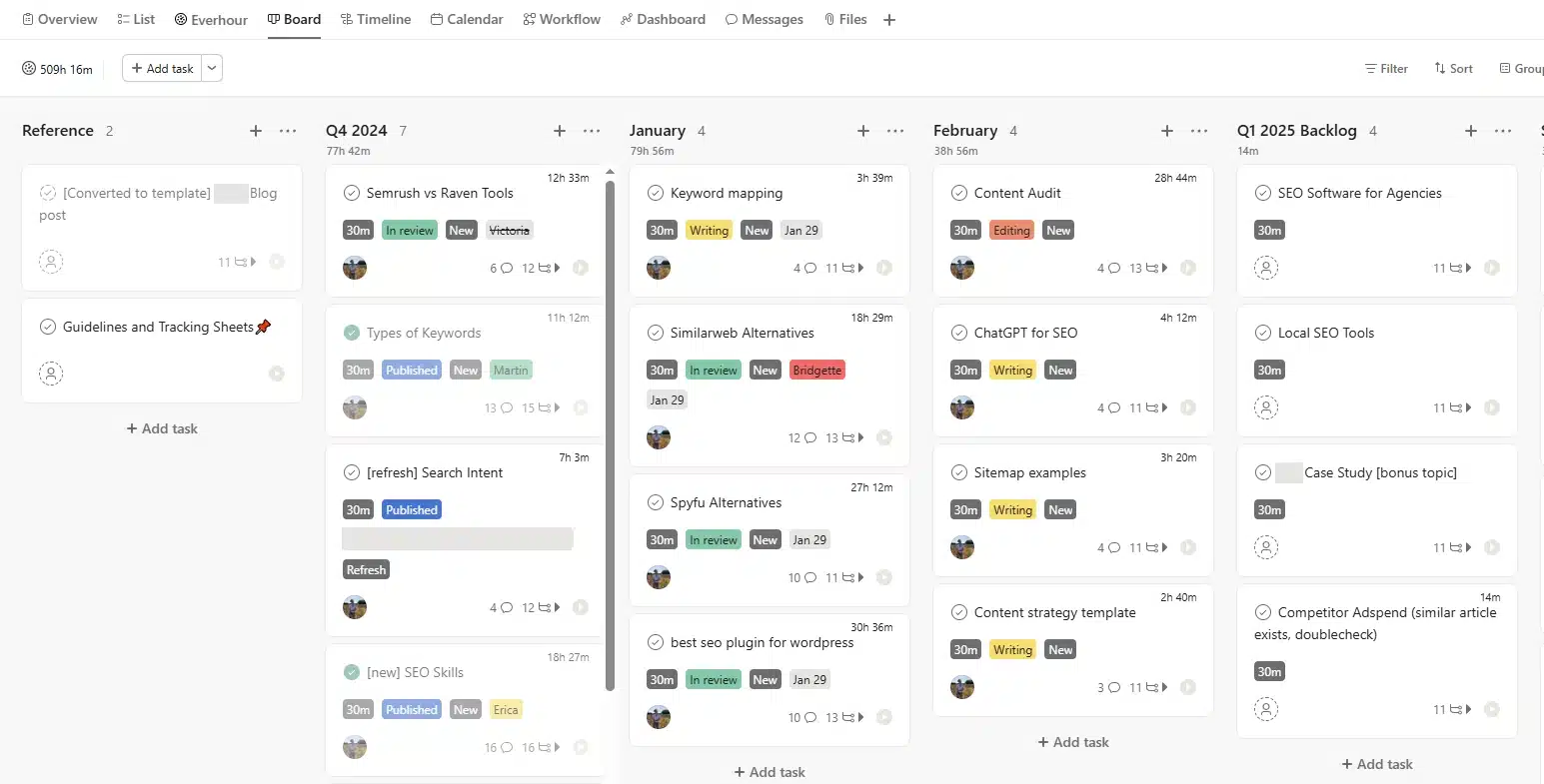
Six weeks gives you enough time to execute meaningfully and see early results, while still staying agile enough to adjust based on performance.
Your calendar should be tailored to your goals and built on a foundation of high-value keywords. Remember, you’re selecting terms not for vanity metrics, but because they reflect real buyer behavior and intent.
These aren’t just isolated blog post ideas. They connect to a broader narrative, guiding users from discovery to decision.
By aligning publication timelines with strategic intent, you ensure that every piece of content supports a measurable outcome from visibility to conversion.
7. Outlining and Writing Content That Aligns With Search Intent
Once the content roadmap is finalized, it’s time to hand off the strategic research to writers through detailed briefs. These customized outlines guide every aspect of the writing process to ensure the final content is aligned with search intent, brand voice, and business objectives.
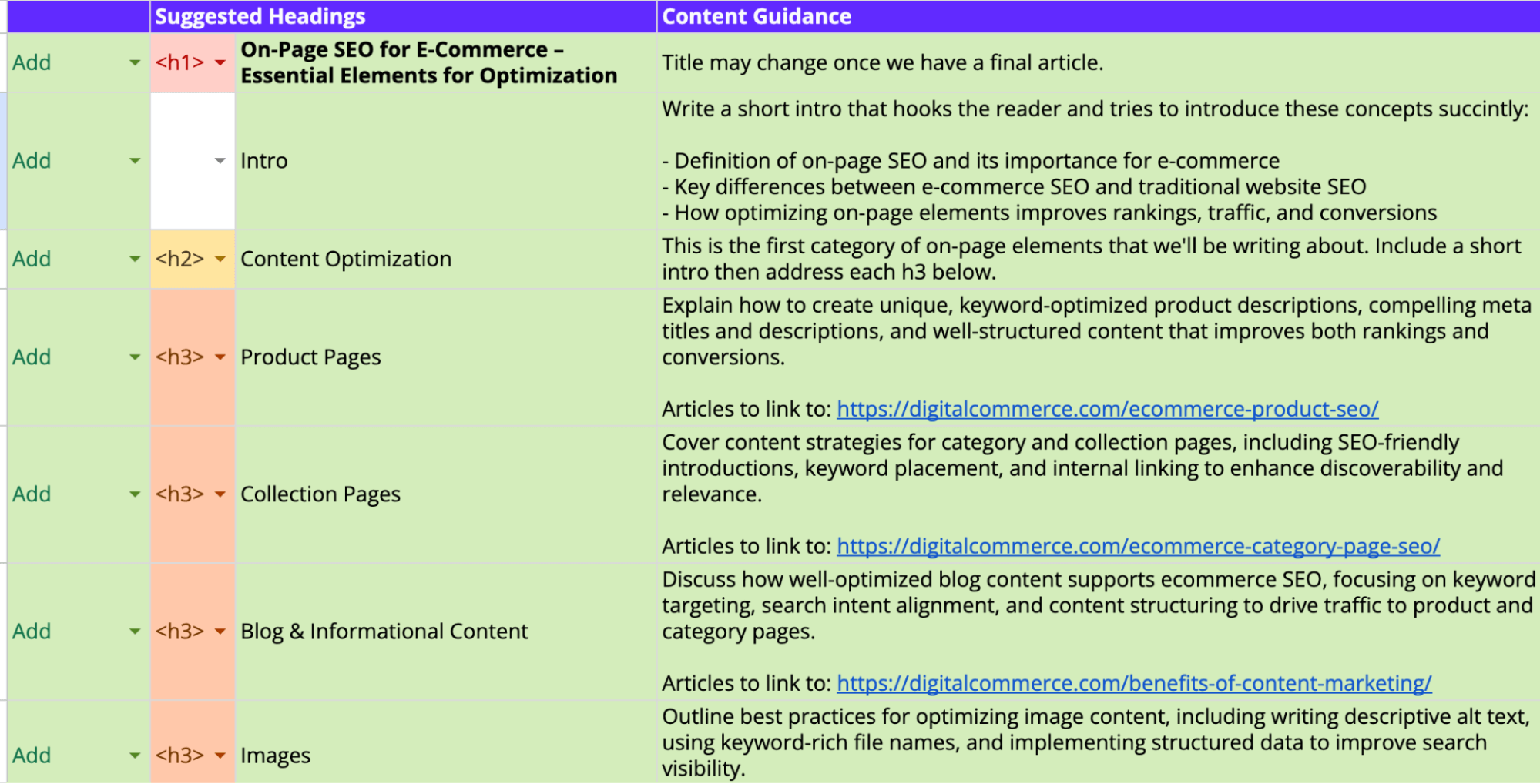
Each brief includes:
- Primary and secondary keyword targets
- Recommended content format and structure (e.g., listicle, comparison, guide)
- Requirements to help it stand out from competitors
- Search intent alignment
- Audience insights and tone-of-voice guidance
- E-E-A-T considerations to build credibility and trust
Our briefs include target word count, heading structure, and guidance to help writers stand out with unique insights that meet the search intent.
Whether it’s a long-form buying guide, a service page, or an educational blog post, content performs best when it’s rooted in strategy, structured for usability, and refined for results.
8. On-Page SEO and Publishing
After the content is written and edited, you need to optimize every element to ensure it ranks well, reads smoothly, and drives action.
At this stage, follow on-page SEO best practices to enhance visibility and usability. This includes:
- Crafting keyword-rich, emotionally compelling titles and meta descriptions
- Optimizing heading structure for readability and scannability
- Compressing and labeling images with relevant alt text for speed and accessibility
- Adding structured data to help search engines understand and feature your content in rich snippets

Enrich your content with helpful visual and interactive elements. Think custom images, comparison tables, embedded videos, or downloadable resources like guides and checklists. These elements can help you better meet the search intent while improving engagement and user value.
Every piece should conclude with a clear, conversion-focused Call-to-Action (CTA) tailored to the content’s purpose and the user’s journey stage. For example:
- A product page might use “Buy now” or “See pricing”
- A lead-gen post could use “Download our free checklist” or “Book a consultation”
- An awareness-stage article may point to “Read the next guide” or “Join our newsletter”
These CTAs create a natural next step, key to improving conversion rates.
9. Strengthen Site Structure with Strategic Internal Linking
Internal linking is one of the most overlooked elements in content strategy, but when done right, it can significantly boost your results.
Internal linking does two key things:
- Reinforces site structure and topical authority, helping search engines understand which pages matter most.
- Guides users deeper into the site, moving top-of-funnel visitors closer to action.
Too often, internal links are added as an afterthought—or worse, left out entirely.
However, you should treat internal links as a core part of content development. Each one is intentional. Links pass relevance and authority between key pages.
They support rankings for target topics. They also guide visitors naturally toward high-converting assets, like product pages, contact forms, or sales funnels.
For example, suppose a blog post targets an early-stage informational query. In that case, you can use internal links to point readers toward related category pages or mid-funnel content, nudging them along the path to purchase.
In ecommerce, this might mean linking from a how-to guide to a curated product category; in B2B, it could be directing readers to a demo page or downloadable resource.
Over time, this builds a content ecosystem that’s not only easier to navigate but also more likely to convert.
10. Promoting Your Content
After publishing, it’s time to promote your content on as many channels as possible to increase interest and visibility.
There are several ways that content can be shared externally, but social media is one of the easiest with the lowest barrier to entry. Twitter, LinkedIn, Instagram, Facebook, and any other social media platform are great tools for exposing content to a large audience and increasing the chances of sharing that content.
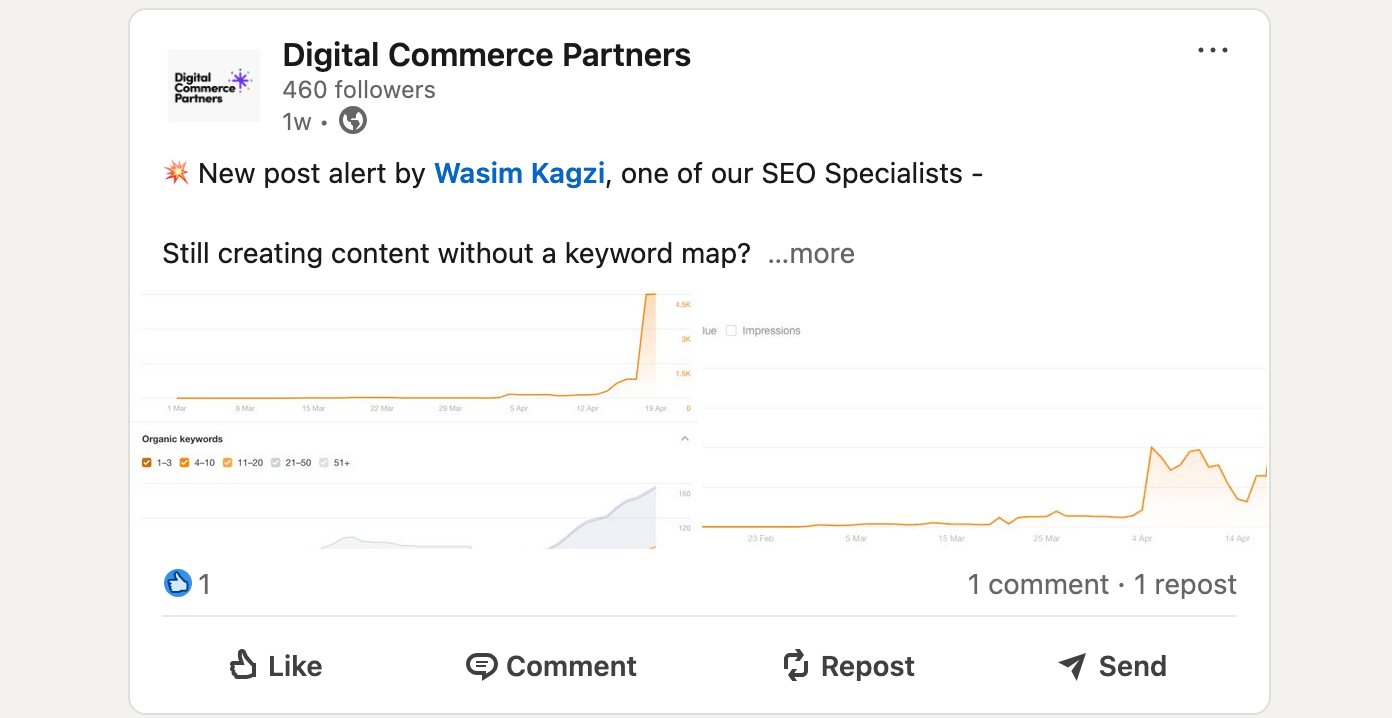
Other ways to promote content include republishing, email outreach, and featuring it on different websites and external publications. This isn’t simply to expose the content to more readers but also to increase the number of backlinks to it.
The more backlinks a piece of content has, the greater the signal to search engines that the content is valuable; therefore, it is more likely to rank higher among search results.
It’s worth noting that you should never pay for backlinks. While it’s a frowned-upon way of increasing search visibility, it’s also likely to be hit hard by search engine penalties, which will erase all of the hard work invested in getting the piece of content to this point.
11. Tracking and Analyzing Your Results
Publishing is not the finish line. It’s the starting point for continuous improvement. To ensure your content continues to perform, track real-world results and use that data to refine, update, and optimize over time.
This step is critical because even the best strategy needs feedback. By actively monitoring how content performs—where it ranks, how users engage, and which pieces convert—you can double down on what works and fix what doesn’t. That’s how you turn content into a long-term asset.
Use tools like Google Search Console and Ahrefs to:
- Monitor keyword rankings, traffic trends, and user behavior
- Audit older content and refresh it to maintain or improve visibility
- Evaluate which distribution channels are driving the best ROI
- Adjust content structure, headlines, or internal links based on performance signals
This feedback loop ensures your investment in content keeps compounding. Instead of letting pages decay over time, treat them like living assets—measured, maintained, and tuned to align with your evolving goals.
Because at the end of the day, you’re not just here to create content—you’re here to drive meaningful, measurable growth.
12. Rinse and Repeat
Content marketing is not a one-time campaign; it’s a continuous cycle of creation, measurement, and optimization, executed with purpose.
Here’s how to make success repeatable:
- Repurpose top-performing content into new formats, such as LinkedIn carousels, podcast episodes, infographics, or webinars, to amplify reach without starting from scratch.
- Refine weaker content by updating information, adding unique insights, improving formatting, enhancing CTAs, or shifting keyword targeting based on performance insights.
- Enforce content quality with clear editorial guidelines, brand voice documentation, and SEO maintenance to ensure consistent performance.
Consistency is key. Successful content marketing is about building a reliable system that delivers results month after month, year after year.
By repeating what works, refining what doesn’t, and staying committed to a structured, data-driven process, you turn your content strategy into a true competitive advantage.
Let Us Create a Content Development Strategy That Achieves Business Goals
Developing a content strategy starts with a solid content development process. If your current efforts aren’t delivering, the foundation may have missed something.
That’s where we come in. At DCP, we help ecommerce brands create targeted strategies that drive traffic, build trust, and boost conversions.
Let’s talk. Reach out today to see how our ecommerce SEO services can help your store grow with content that actually works.

